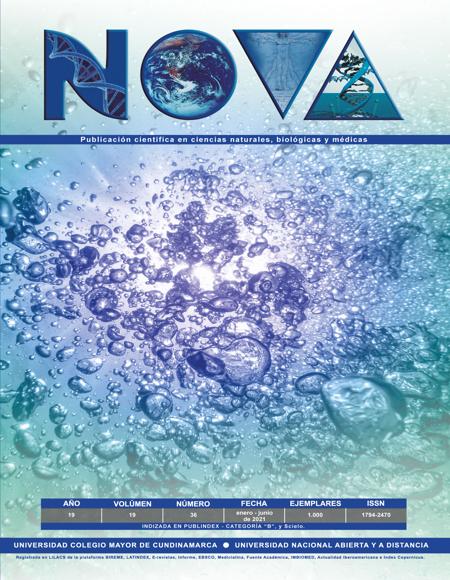Caenorhabditis elegans como modelo de infección para el estudio de antimicrobianos.
Caenorhabditis elegans as an infection model for the study of antimicrobials.

NOVA por http://www.unicolmayor.edu.co/publicaciones/index.php/nova se distribuye bajo una Licencia Creative Commons Atribución-NoComercial-SinDerivar 4.0 Internacional.
Así mismo, los autores mantienen sus derechos de propiedad intelectual sobre los artículos.
Mostrar biografía de los autores
A pesar de algunas limitaciones éticas, los animales juegan un papel importante como anfitriones sustitutos para investigar los mecanismos fisiopatológicos de enfermedades con el fin de indagar en ellos medicamentos contra diferentes patologías. Uno de los grandes problemas en salud pública a nivel mundial en el contexto farmacológico es la producción de antibióticos y la ocurrencia de resistencia microbiana, además, cada vez resulta más complejo el uso de modelos animales por las restricciones bioéticas actuales, no obstante, es necesario usar modelos simples en los estudios preliminares que permitan evaluar las interacciones huésped-patógeno-antimicrobiano. Al validar que Caenorhabditis elegans es susceptible a varias bacterias y además tiene la capacidad de responder a estímulos ambientales con cambios observables en el comportamiento tras ser alimentado con diversas bacterias, resulta muy útil usarlo en este tipo de investigaciones ya que tiene una vida promedio corta y no cuenta con restricciones éticas para su uso. Por lo anterior, en este artículo se revisa la susceptibilidad que tiene C.elegans de infectarse con diferentes bacterias, además, ya que aún no se ha validado completamente como modelo para poner a prueba antimicrobianos se propone que este nematodo es útil como modelo In vivo para evaluar infecciones y tratamientos antibacterianos.
Visitas del artículo 412 | Visitas PDF 268
Descargas
- Wiles S. All models are wrong, but some are useful: Averting the 'microbial apocalypse'. Virulence. 2015;6(8):730-2.
- Meurens F, Summerfield A, Nauwynck H, Saif L, Gerdts V. The pig: a model for human infectious diseases. Trends in microbiology. 2012;20(1):50-7.
- Duval RE, Grare M, Demore B. Fight Against Antimicrobial Resistance: We Always Need New Antibacterials but for Right Bacteria. Molecules. 2019;24(17).
- Zhao M, Lepak AJ, Andes DR. Animal models in the pharmacokinetic/pharmacodynamic evaluation of antimicrobial agents. Bioorganic & medicinal chemistry. 2016;24(24):6390-400.
- Tunkel AR, Scheld WM. Applications of therapy in animal models to bacterial infection in human disease. Infectious disease clinics of North America. 1989;3(3):441-59.
- Baldelli I, Biolatti B, Santi P, Murialdo G, Bassi AM, Santori G, et al. Conscientious Objection to Animal Testing: A Preliminary Survey Among Italian Medical and Veterinary Students. Alternatives to laboratory animals : ATLA. 2019;47(1):30-8.
- Kumar A, Baruah A, Tomioka M, Iino Y, Kalita MC, Khan M. Caenorhabditis elegans: a model to understand host-microbe interactions. Cellular and molecular life sciences : CMLS. 2020;77(7):1229-49.
- Maupas E. Modes et formes de reproduction des nématodes1900.
- NCBI. Taxonomy browser Caenorhabditis elegans 2020 [updated 2020; cited 2020 11/06/2020]. Available from: https://www.ncbi.nlm.nih.gov/Taxonomy/Browser/wwwtax.cgi?mode=Info&id=6239&lvl=3&keep=1&srchmode=1&unlock&lin=s&log_op=lineage_toggle.
- Dougherty EC, V. N. A new species of the free-living nematode genus Rhabditis of interest in comparative physiology and genetics. Journal of Parasitology. 1949;35(11).
- Riddle DL, Blumenthal T, Meyer BJ ea, editors. C. Elegans II. 2nd Edition. Nueva York: Cold Spring Harbor Laboratory Press; 1997.
- Ann K. Corsi, Bruce Wightman, Chalfie M. A Transparent window into biology: A primer on Caenorhabditis elegans New York2015 [cited 2020 11/06/2020]. Available from: http://www.wormbook.org/chapters/www_celegansintro/celegansintro.html.
- Gonzalez-Moragas L, Roig A, Laromaine A. C. elegans as a tool for in vivo nanoparticle assessment. Advances in colloid and interface science. 2015;219:10-26.
- Wormatlas. 2020 [cited 2020 11/06/2020]. Available from: https://www.wormatlas.org/.
- Prevedel R, Yoon YG, Hoffmann M, Pak N, Wetzstein G, Kato S, et al. Simultaneous whole-animal 3D imaging of neuronal activity using light-field microscopy. Nature methods. 2014;11(7):727-30.
- Schedl T, Kimble J. fog-2, a germ-line-specific sex determination gene required for hermaphrodite spermatogenesis in Caenorhabditis elegans. Genetics. 1988;119(1):43-61.
- L'Hernault SW, Arduengo PM. Mutation of a putative sperm membrane protein in Caenorhabditis elegans prevents sperm differentiation but not its associated meiotic divisions. The Journal of cell biology. 1992;119(1):55-68.
- Tan M-W, Rahme LG, Sternberg JA, Tompkins RG, Ausubel FM. Pseudomonas aeruginosa killing of Caenorhabditis elegans used to identify P. aeruginosa virulence factors. Proceedings of the National Academy of Sciences. 1999;96(5):2408-13.
- Couillault C, Ewbank JJ. Diverse bacteria are pathogens of Caenorhabditis elegans. Infection and immunity. 2002;70(8):4705-7.
- Mahajan-Miklos S, Tan MW, Rahme LG, Ausubel FM. Molecular mechanisms of bacterial virulence elucidated using a Pseudomonas aeruginosa-Caenorhabditis elegans pathogenesis model. Cell. 1999;96(1):47-56.
- Gallagher LA, Manoil C. Pseudomonas aeruginosa PAO1 kills Caenorhabditis elegans by cyanide poisoning. Journal of bacteriology. 2001;183(21):6207-14.
- Darby C, Cosma CL, Thomas JH, Manoil C. Lethal paralysis of Caenorhabditis elegans by Pseudomonas aeruginosa. Proceedings of the National Academy of Sciences of the United States of America. 1999;96(26):15202-7.
- Arnaud Labrousse, Sophie Chauvet, Carole Couillault, C. Léopold Kurz, Ewbank JJ. Caenorhabditis elegans es un huésped modelo para Salmonella typhimurium. Current Biology. 2000;10(23).
- Aballay A, Yorgey P, Ausubel FM. Salmonella typhimurium proliferates and establishes a persistent infection in the intestine of Caenorhabditis elegans. Current biology : CB. 2000;10(23):1539-42.
- Aballay A, Drenkard E, Hilbun LR, Ausubel FM. Caenorhabditis elegans innate immune response triggered by Salmonella enterica requires intact LPS and is mediated by a MAPK signaling pathway. Current biology : CB. 2003;13(1):47-52.
- Tenor JL, McCormick BA, Ausubel FM, Aballay A. Caenorhabditis elegans-based screen identifies Salmonella virulence factors required for conserved host-pathogen interactions. Current biology : CB. 2004;14(11):1018-24.
- O'Quinn AL, Wiegand EM, Jeddeloh JA. Burkholderia pseudomallei kills the nematode Caenorhabditis elegans using an endotoxin-mediated paralysis. Cellular microbiology. 2001;3(6):381-93.
- Gan YH, Chua KL, Chua HH, Liu B, Hii CS, Chong HL, et al. Characterization of Burkholderia pseudomallei infection and identification of novel virulence factors using a Caenorhabditis elegans host system. Molecular microbiology. 2002;44(5):1185-97.
- Garsin DA, Sifri CD, Mylonakis E, Qin X, Singh KV, Murray BE, et al. A simple model host for identifying Gram-positive virulence factors. Proceedings of the National Academy of Sciences of the United States of America. 2001;98(19):10892-7.
- Jansen WT, Bolm M, Balling R, Chhatwal GS, Schnabel R. Hydrogen peroxide-mediated killing of Caenorhabditis elegans by Streptococcus pyogenes. Infection and immunity. 2002;70(9):5202-7.
- Sifri CD, Begun J, Ausubel FM, Calderwood SB. Caenorhabditis elegans as a model host for Staphylococcus aureus pathogenesis. Infection and immunity. 2003;71(4):2208-17.
- Hodgkin J, Kuwabara PE, Corneliussen B. A novel bacterial pathogen, Microbacterium nematophilum, induces morphological change in the nematode C. elegans. Current biology : CB. 2000;10(24):1615-8.
- Park JO, El-Tarabily KA, Ghisalberti EL, Sivasithamparam K. Pathogenesis of Streptoverticillium albireticuli on Caenorhabditis elegans and its antagonism to soil-borne fungal pathogens. Letters in applied microbiology. 2002;35(5):361-5.
- Darby C, Hsu JW, Ghori N, Falkow S. Caenorhabditis elegans: plague bacteria biofilm blocks food intake. Nature. 2002;417(6886):243-4.
- Joshua GWP, Karlyshev AV, Smith MP, Isherwood KE, Titball RW, Wren BW. A Caenorhabditis elegans model of Yersinia infection: biofilm formation on a biotic surface. Microbiology. 2003;149(11):3221-9.
- Mallo GV, Kurz CL, Couillault C, Pujol N, Granjeaud S, Kohara Y, et al. Inducible antibacterial defense system in C. elegans. Current biology : CB. 2002;12(14):1209-14.
- Hodgkin J, Partridge FA. Caenorhabditis elegans meets microsporidia: the nematode killers from Paris. PLoS biology. 2008;6(12):2634-7.
- Mylonakis E, Ausubel FM, Perfect JR, Heitman J, Calderwood SB. Killing of Caenorhabditis elegans by Cryptococcus neoformans as a model of yeast pathogenesis. Proceedings of the National Academy of Sciences of the United States of America. 2002;99(24):15675-80.
- Feistel DJ, Elmostafa R, Nguyen N, Penley M, Morran L, Hickman MA. A Novel Virulence Phenotype Rapidly Assesses Candida Fungal Pathogenesis in Healthy and Immunocompromised Caenorhabditis elegans Hosts. mSphere. 2019;4(2).
- Breger J, Fuchs BB, Aperis G, Moy TI, Ausubel FM, Mylonakis E. Antifungal chemical compounds identified using a C. elegans pathogenicity assay. PLoS pathogens. 2007;3(2):e18.
- Pukkila-Worley R, Peleg AY, Tampakakis E, Mylonakis E. Candida albicans hyphal formation and virulence assessed using a Caenorhabditis elegans infection model. Eukaryotic cell. 2009;8(11):1750-8.
- Alegado RA, Campbell MC, Chen WC, Slutz SS, Tan MW. Characterization of mediators of microbial virulence and innate immunity using the Caenorhabditis elegans host-pathogen model. Cellular microbiology. 2003;5(7):435-44.
- Ewbank JJ, Zugasti O. C. elegans: model host and tool for antimicrobial drug discovery. Disease models & mechanisms. 2011;4(3):300-4.
- Roeder T, Stanisak M, Gelhaus C, Bruchhaus I, Grotzinger J, Leippe M. Caenopores are antimicrobial peptides in the nematode Caenorhabditis elegans instrumental in nutrition and immunity. Developmental and comparative immunology. 2010;34(2):203-9.
- Kato Y, Aizawa T, Hoshino H, Kawano K, Nitta K, Zhang H. abf-1 and abf-2, ASABF-type antimicrobial peptide genes in Caenorhabditis elegans. The Biochemical journal. 2002;361(Pt 2):221-30.
- Schulenburg H, Kurz CL, Ewbank JJ. Evolution of the innate immune system: the worm perspective. Immunological reviews. 2004;198:36-58.
- Nicholas HR, Hodgkin J. Responses to infection and possible recognition strategies in the innate immune system of Caenorhabditis elegans. Molecular immunology. 2004;41(5):479-93.
- Mary R. Brockett, Patrick S. Spica, Shinn-Thomas JH. C. elegans synchronization: Small- and large-scale protocols to isolate synchronized L1 larvae and beyond New York2016 [updated 2016; cited 2020 11/06/2020]. Available from: http://wbg.wormbook.org/2016/05/16/c-elegans-synchronization-small-and-large-scale-protocols-to-isolate-synchronized-l1-larvae-and-beyond/.
- Stiernagle T. Maintenance of C. elegans Minneapolis2006 [updated 2006; cited 2020 11/06/2020]. Available from: http://www.wormbook.org/chapters/www_strainmaintain/strainmaintain.html.
- Park HH, Jung Y, Lee SV. Survival assays using Caenorhabditis elegans. Molecules and cells. 2017;40(2):90-9.
- Sanchez-Blanco A, Kim SK. Variable pathogenicity determines individual lifespan in Caenorhabditis elegans. PLoS genetics. 2011;7(4):e1002047.
- Bustos AVG, Jimenez MG, Mora RMS. The Annona muricata leaf ethanol extract affects mobility and reproduction in mutant strain NB327 Caenorhabditis elegans. Biochemistry and biophysics reports. 2017;10:282-6.
- Parada Ferro LK, Gualteros Bustos AV, Sánchez Mora RM. Caracterizacion fenotipica de la cepa N2 de Caenorhabditis elegans como un modelo en enfermedades neurodegenerativas. NOVA. 2017;15:69.
- Sugawara T, Sakamoto K. Killed Bifidobacterium longum enhanced stress tolerance and prolonged life span of Caenorhabditis elegans via DAF-16. British Journal of Nutrition. 2018;120(8):872-80.
- MacNeil LT, Watson E, Arda HE, Zhu LJ, Walhout AJ. Diet-induced developmental acceleration independent of TOR and insulin in C. elegans. Cell. 2013;153(1):240-52.
- Sharika R, Subbaiah P, Balamurugan K. Studies on reproductive stress caused by candidate Gram positive and Gram negative bacteria using model organism, Caenorhabditis elegans. Gene. 2018;649:113-26.
- Okoli I, Coleman JJ, Tampakakis E, An WF, Holson E, Wagner F, et al. Identification of antifungal compounds active against Candida albicans using an improved high-throughput Caenorhabditis elegans assay. PloS one. 2009;4(9):e7025.
- Duncan D. Cameron, Jurriaan Ton, Alejandro Pérez de Luque. Mycocrop United Kingdom2013 [updated 2015; cited 2020 11/06/2020]. Available from: https://mycocrop.wordpress.com/summary-results/.
- Garsin DA, Villanueva JM, Begun J, Kim DH, Sifri CD, Calderwood SB, et al. Long-lived C. elegans daf-2 mutants are resistant to bacterial pathogens. Science. 2003;300(5627):1921.
- Kniazeva M, Ruvkun G. Rhizobium induces DNA damage in Caenorhabditis elegans intestinal cells. Proceedings of the National Academy of Sciences of the United States of America. 2019;116(9):3784-92.
- Jurado-Gamez H, Gúzman-Insuasty M. Determinación de la cinética, pruebas de crecimiento y efecto de inhibición in vitro de Lactobacillus casei en Staphylococcus aureus , Staphylococcus epidermidis , Streptococcus agalactiae y Escherichia coli. Revista de la Facultad de Medicina Veterinaria y de Zootecnia. 2015;62.





